Na Paniolo ‘O Waimea
The Roots of Ranching on the Big Island
Nestled within Parker Ranch, the largest, singly-owned working ranch in the U.S., Waimea has a long history of ranching that continues today. However, the eventual establishment of Parker Ranch resulted from the intertwined destinies of ancient Hawaii and the influences of westerners who arrived on the shores of Hawaii Island.
Undiscovered by Europeans until the late 18th century, Hawaii soon became an important stop on busy trade routes across the Pacific. Kawaihae Harbor, on the northwest coast of the Island and ten miles west of the center of Waimea district and Parker Ranch, provided the contact point for various westerners and local island residents. The early beginnings of this east / west contact were presided over by King Kamehameha I, who in the midst of his efforts to unify the islands, was provided with firearms and two westerners, John Young and Isaac Davis, who knew how to use them.
While Kamehameha’s successful unification efforts provided internal stabilization, new western influences began to exert a more subtle change. In 1793, not long after unification, Captain Vancouver arrived with the gift of cattle he had purchased in California. He presented these to King Kamehameha with the suggestion that he place them under his protection for the next ten years. With a strict kapu in place, it didn’t take long before the plains of Waimea were crowded with cattle. In Aloha Cowboys Virginia Cowan-Smith and Bonnie Domrose-Stone describe the impact:
Vast herds of these long-horned beasts roamed freely throughout the island and quickly became a nuisance. The cattle, called ‘pipi’ by the Hawaiians, from the English word ‘beef’, were soon destroying crops of taro, banana, and papaya and often attacking the natives as well. The Hawaiians tried building walls around their huts and around their crops but met with little success. The rampaging cattle went either through or over the barricades, trampling everything in their path.
The impact of the cattle can be seen today in the serpentine rock walls, built to keep out the early wild cattle, that weave through a timeless rugged terrain, marking early village sites.
Young and strong John Parker soon found himself riding a wave of change. When he arrived on the North Hawaii Island, a seaman tired of travel, he embraced the people and lifestyle he found. Like John Young and Isaac Davis he was befriended by King Kamehameha and eventually married King Kamehameha I’s granddaughter, Kipikane, settling on Waiapuka, his home in Kohala. However, Parker made many trips to the plains of Waimea, which was soon to become his home.
Kamehameha having lifted the kapu on killing cattle Parker was often encountered hunting bullocks on the Waimea Plains and was renowned for his skill. Traveling on foot, he tracked the wild cattle through the forests and plains of Waimea. William Ellis, an English missionary, encountered Parker at his camp in Waimea where, “The beauty of the place was almost unnatural, enchanting. Stretching above the reddish tinted water of a number of dancing streams the symmetrical, pyramid-like shapes of the Kohalas stood like the ruins of some forgotten civilization.” (Wellmon, 32) It was no wonder that Parker eventually moved his family to Waimea.
But before Parker could establish his ranch in Waimea, another change had to take place. The land tenure system, which was based on an ancient hierarchy of chiefs, did not permit private ownership of land. Instead, favored chiefs were given a section of land called an ahupua’a, which ran in a pie shape from the mountains to the sea. In turn, sections of that land were divided based on geographic features and granted to specific persons who were trained in the stewardship of those divisions and passed the knowledge on to the next generation.
However, these land grants were not absolute and could just as easily be reclaimed by the ruling chief and they were also exclusive with a few exceptions, of non-Hawaiians. In 1839 the “Bill of Rights” was enacted that changed the monarchy to a constitutional one and created a Land Commission. During this time, Parker established claim to the land near the foothills of Mauna Kea that he held with a lease agreement. After petitioning the Land Commission, he was granted the 12 homestead acres that was soon to grow into a vast cattle operation known as Parker Ranch.
The next challenge was of the four legged variety. In order to have a cattle ranch, it is necessary to catch and corral the livestock. After ten years, when the kapu was lifted by King Kamehameha, safely capturing the animals became the next problem. Bullock hunting using trained dogs and pits, was slow and sometimes dangerous work. The introduction of horses by Captain Richard J. Cleveland in 1803, provided the potential solution to this problem, although it was a few years still before horses were to be employed.
King Kamehameha III (Liholiho), realizing the value of using horses to manage cattle and also seeing the need for trained riders, invited the first cowboys, known as vaqueros, to the Big Island. These vaqueros, who arrived in 1832 from Mexico (now California) were skilled riders, cattle herders and leather workers, giving rise to the term paniolo. “Hawaiians quickly adapted to the skills of the vaqueros. In the summer of 1830, Liholiho and others of his court rode toward the southwest slope of Mauna Kea from Waimea village to climb the mountain. One observer recalled that ‘the King appeared affable, kind and teachable on horseback,’ and successfully captured a young yearling bullock for lunch” (Wellmon, 44).
The skills of the vaqueros established formal cattle ranching in Waimea. “Horseman became a common sight. Captured mountain cattle were domesticated. Corrals and cattle pens were erected….These new ways became part of the heritage of the area, and in the following years Waimea emerged as an important cattle-raising frontier” (Wellmon, 46)
Five Paniolos
What follows are five short articles derived from interviews done by Waimea Middle School 7th and 8th graders through a grant project funded by Hawaii Community Foundation. This project offered an opportunity for students to study local history, learn about doing oral history and to interview five paniolos and record their stories and hopefully gain some insight into the ranching life of Waimea.
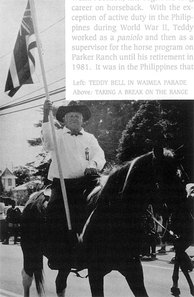
Teddy Bell strode into Thelma Parker Library with the quiet self-assurance of someone who has seen it all and stayed on his horse. Born in Waimea on August 14, 1923, Teddy Bell spent part of his childhood in Waiki’i where his father was a foremant for the Parker Ranch farming operation. There was a small community in Waiki’I at that time, and from third grade on, Teddy attended a one-room school with about thirty students.
The day after finishing 8th grade, Teddy began working as a paniolo for Parker Ranch. “We got out of school, say June 9th; the 10th I was working already. You feel beat when you start working. Fifty cents a day.” Teddy started as a paniolo in the Waike’I section; this began his long career on horseback. With the exception of active duty in the Philipines during World War II, Teddy worked as a paniolo and then as a supervisor for the horse program on Parker Ranch until his retirement in 1981.
It was in the Philipines that the fortitude, which came from his early paniolo experience served him well. “At time of war, no one can tell me they are not afraid. But you got a job to do and you have to do it.” The war ended on Teddy’s 22nd birthday, but he wasn’t celebrating. “The first time they came in, you know, when Japan surrendered, it was August 14, 1945. I can’t forget that day…It was a nasty day, but we were lucky. We’re back home here today...”
While finishing his time in the service on O’ahu, Teddy met his wife Pi’ilani. When asked how he met her, a sparkle appeared in his eyes and with a chuckle he simply stated, “While I was in the service, and I met her in Honolulu—she’s from Hilo. That’s how we got acquainted.” As hard as we tried, we could not pry that story from him.
When he returned to Parker Ranch, Teddy began working with the horse program which he likened to building a car. “You want to train a horse so he’s something like a car. You know the difference between a Jeep and a Cadillac—a Cadillac is something very comfortable. A jeep is very uncomfortable. That’s same like a horse. You want a good, well-trained horse, it will be like a Cadillac.”
After forty-plus years with Parker Ranch, Teddy Bell retired, but he hasn’t stopped working. As well as doing a little cattle ranching himself, Teddy is inspired by his love of horses and his concern for the youth of our community, to volunteer his time teaching young kids to ride.
Teddy Bell passed away on July 18, 2002 and was inducted into the Paniolo Hall of Fame posthumously later in 2002.
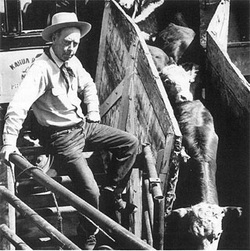
Next time you are driving down Palani Road into Kona, think of Rally Greenwell; that road was named after his father. Born in Kona in 1914, Rally grew up with ranching. Riding from the time he was three, he helped his father on the family ranch, also named Palani after his father Frank. Rally is a tall, gracious man with a sense of humor that puts everyone in his presence at ease.
Always preferring to be riding the range, Rally “didn’t like school, period.” But his parents had other ideas and he ended up completing twelve years of schooling, beinning with a one-room school in Kona. “In those days, there were few schools around and I went to a little, private school in Kona with ten or twelve children. And the grades, there were probably three or four different grades. So, you can see, it was just a small school.”
At the age of eleven, Rally continued his education at a private school in the San Francisco area, and had the adventure of traveling with his two brothers on a Matson ship. “Once you got over the seasickness, it was a lot of fun. They had different games that you would play and there would be quite a few other local kids on the boat that would be going back to school or something, so you would get to know them...”
However, seasickness was not the only sickness he felt; Rally missed his home in the islands. After completing his schooling at Roosevelt High School in Honolulu, Rally returned to his beloved Big Island and began working at Parker Ranch.
Rally was with the ranch for ten years when his agricultural deferment expired and he was to be drafted into the service. However, it was not to be. “I took my physical and I was ready to go into the service and I left Parker Ranch. I went home to Kona that night and somehow, Mr. Von Holt, who was manager and half owner of Kahua (ranch), heard about me leaving Parker Ranch, so he called me up and asked me if I wanted to come and work for him. And I said, ‘Well, Mr. Von Hold, I’m sorry I’ve taken my physical, I’m going into the army.’ And he said, ‘I’m chairman of the draft board. I can take care of that for you.’ Because switching from here going up there, I was changing jobs, going into agriculture again, so I could get another deferment.”
It was at Kahua Ranch that Rally met his wife Pat, who was visiting from O’ahu. Ever wonder how Buster Brown got its name? “She (Pat) lived in Honolulu and she was visiting her cousin, Buster Brown, who lived in Waimea here; they named this hill up here Buster Brown Hill. The Marines named it Buster Brown Hill because he lived just below the hill there and they got to know him.” Pat and Rally’s mutual love for riding led to a lifelong partnership.
After eight years with Kahua Ranch, Rally returned to Parker Ranch where he remained for nine years as manager until his retirement. The paniolo life is the only life that Rally has known or wanted to know. “Well, if I had to do my life all over again, I would do it exactly the same way. I really have enjoyed my life. It has been hard worked but it has been a lot of fun. I think it was quite different then what it is today. We used to drive cattle for miles and miles….from here down to the pier at Kawaihae.”
His only regret is that the paniolo today cannot experience the freedom of riding miles of range as he had the opportunity to do. But actively rode the range in his own way; up until his passing a few years ago, you could see him in his signature broad-brimmed, white hat, driving around town in a vintage green Land Rover.
Rally passed away in June 2006 at the age of 92.
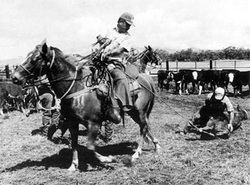
Coming to the interview straight from work on a Friday afternoon, Charlie Kimura must have been ready for pau hana, but he still had the time and energy to share his story with us. Born in Waimea in 1931, Charlie Kimura is the youngest of the interviewees. He has spent most of his life in this community, with the exception of a stint in the Marines. While he has had opportunities to leave, Charlie wanted to come back to Parker Ranch and the life he loved.
He has worked as a paniolo, but also followed in his father Yutaka’s footsteps to workd with the cattle breeding program. “See, when I was a young boy before I went to school, my dad was foreman of the Holstein Dairy and they kept a lot of records. You know, milk production. I fell in love with that kind of stuff, so I stayed on. And then as I grew up, you know, you like horses, but I got to learn. My dad says, ‘It’s not a horse ranch, it’s a cattle ranch, so put your emphasis on cattle, not horses.’”
Living with his family in the outer reaches of the Parker Ranch, Charlie loved everything about ranching. He began to ride when he was three and enjoyed a life populated with animals. “We lived up in the mountain until I started school. My older brothers and sisters came down and lived with my grandparents. But when I started school, we moved to Waimea…In those days when you live up the mountain, we didn’t see too many people. When we came down to Waimea, when we went to school, we were like wild people and afraid of people.”
Charlie attended both Waimea School and the Japanese School (located next to Church Row). “Then the war started in 1941 when I had just started fifth grade, and every thing stopped…The English school here, this Waimea School, was taken over by the hospital, and we had to go to school in private homes for a couple of years untile they built a temporary school by the Episcopal Church.”
Although World War II brought upheaval to life in Waimea, it also brought unexpected pleasures such as rodeos. “There was one rodeo down here. It was at Puihale and all the Marines were there. And they didn’t build an arena, they just, the Marines were the arena! They stacked them on the side and they let the animals out and the cowboys roped the cows or steers or whatever it was. The marines just jumped on them and tackled them down, so they enjoyed themselves. Parker Ranch put out a big barbecue and they had about twenty-five cattle to barbecue. The Marines cooked the barbecue and everybody, we were just like family, we just walked right in there. We used to go to outdoor movies in the Marine camps.”
Beginning at the age of twelve, Charlie started to work for Parker Ranch in the summers milking cows. After graduation from high school, Charlie began full-time work building fences, then moving up to paniolo. Eventually, he became involved with the cattle breeding division of the ranch. Although he didn’t attend college, Charlie continued to learn his craft. “I went on learning. I mean, practical schooling that I had on the rand, but you don’t move up in position as fast as if you had some, ou know more education. So, I went to short courses of cattle schools to pick up all of these things. In 1960, I had a tutor for a month who shoed me genetics because I was in charge of the register herd.”
After being a livestock manager for seven years, Charlie became a division supervisor. The ranching life, with its limitless variation continues to hold his fascination and admiration. “When you work with cattle, every day is different.”
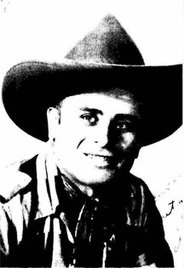
John Lindsey exudes the kind of energy that defies his eighty-three years and left us chasing him down memory lane. That life force has served him well throughout a varied career as ranch hand, paniolo and construction worker.
Growing up, John found little opportunity for his energy to get him into much trouble though, because his grandfather was the local truant officer. He rode a large, white horse and made it his business to know the location of every school age child in Waimea. “Our time, the other boys who went to school, they never had time to fool around. The truant officer would come in the morning and check out absentees. He would check everyone. There were two kids where Lakeland is. One boy never showed. He got there about 9:30 or 10:00. Turned out he caught the boy playing in the yard, made him dress and the boy, from there, walked all the way to school.”
John went directly from eighth grade to work for Parker Ranch. “After I got out of the eighth grade, I ran from here to that office up there. Parker Ranch office was there. There was a post office, the Parker Ranch office, a store. I walked into the office, the main man was there – Carter. He looked at me and says, ‘What you want?’ … ‘Mr. Carter, I want a job.’ ‘You want to work or you want to play?’ I said, ‘Work.’ “yhou start Monday.’ Just like that. I mean work!”
John wasn’t kidding. His early experiences were varied and served to prepare him for later career changes. “I did everything. I dug ditches, I laid pipeline, I did fencing and everything else.” One of those jobs involved working in the farming operation at Waiki’i. “There were different seasons, like at Wiki’i we grew corn and all that…They grew hay, and in the season we got a crew there. It was a labor crew. Then they cut the corn, mow the hay – not with new-fangled machines, with horse and sickle. Then they raked it.”
John began riding with the cowboy gang, moving cattle down to Kawaihae. To protect them from the midday sun, they were taken part way down the hill on one day and then, beginning at around 1:00 a.m. the next, were driven the rest of the way to Kawaihae. “That time we didn’t have roads, no nothing there. But they had that big tree; they made a cattle road there and what you call a pasture. In the meantime, there’s other cattle grazing in that area…On a moonlit night, it was like driving cattle during the day. Beautiful, beautiful.”
After 13 years with Parker Ranch, John set off to Honolulu where he workded in the Navy shipyard during the war and later in construction, both on O’ahu and Wake Island. He eventually returned with his wife to Waimea where he now lives with his daughter, Helen and grandson, Shai-Anthony.
John Lindsey passed away in 1998, not long after the completion of this project.
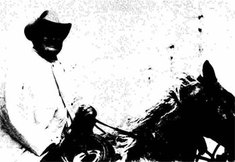
Jiro Yamaguchi’s shy demeanor belies his hard riding life. After completing elementary school in 1938, “We started first grade, baby class. At the end of the building was the seventh grade. That’s when I quit school”, Jiro began his official career with Parker Ranch. Although it was not his first experience working for them. “Saturdays, Parker Ranch used to hire the Boy Scouts to work – take like a test…take you out to the fields. Work digging weeds, pulling grass, going up the pipeline, tape the pipelines.”
After a kind of apprenticeship as a general ranch hand, Jiro carried on from his father and began the job that was in his blood – paniolo. “Yeh, but you know to start most people, most employees start out slowly with mending the fence. But like us, my family, most all of us could ride horses because by dad was a cowboy. They used to put us on the horse all the time. Summertime, I used to go with him early in the morning.”
What is that saying? The quickest road to a man’s heart is through his stomach. This may have been the case here as Jiro met his wife, Asako, at the Parker Ranch Restaurant where she worked at the time. Because it was wartime, and the church was being used by troops, Jiro and Asako were married in the home of the priest from the Imiola Church.
Another skill Jiro acquired from his day was roping. “You have to learn because my dad was a pretty good roper. So what I did was practice roping kids, roping friends, chasing wild pig and started that way.” Jiro’s special skill with roping also got him in commercials that were seen in such far-flung places as Germany. “We used to drive horses, drive cattle to make a commercial. You have to rope the heifer and take it all on video for commercial. Then I did one roping down at this corral down there – roping horse for a guy from UCLA. Then the commercial went to Germany or someplace like that.”
At first, because of a Parker Ranch rule against their paniolo participating in rodeos, Jiro had to be satisfied honing his skill on the job. Eventually, permission was granted and Jiro was off on his rodeo career. When he retired in 1990, Jiro continued roping and sharing his skills with the youth of the community.
Jiro passed away in July 2004.
All but one of these fine men have passed on but their contributions and stories will live on. They were part of the living Aloha that makes Waimea a special place to live.

 RSS Feed
RSS Feed
